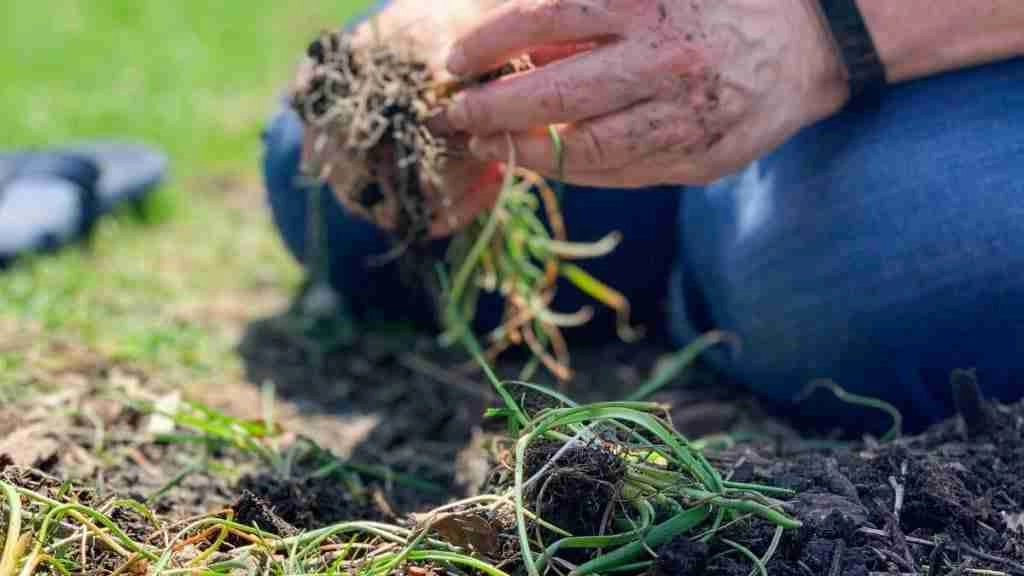
Manganese toxicity is one of the most common among all micronutrient toxicities. A high level of manganese in the soil has a detrimental effect on plant growth. It affects plants’ physiological and chemical processes at a cellular level and may end in their sterility.
High levels of manganese can be corrected by increasing the soil pH by adding dolomite or lime to the soil to raise the pH above 5.3. It can also be fixed by waterlogging and improved drainage. To avoid fluctuations, manganese level and soil moisture should also be maintained constant.
Learn more about how to lower manganese levels below. We’ll also be diving into average levels and identifying some of the factors that cause the soil levels to vary as well.
See also: Is Sulfur Good For The Garden? Pros & Cons Of Using It
How to Lower Manganese Levels
Below are some strategies that are recommended for the treatment of high soil levels of manganese:
1- Stop Using Fertilizer
The first strategy is to stop applying fertilizer that contains manganese. The labels of fertilizers and soil supplements should be read carefully.
They should be read to determine if manganese, iron, copper, zinc, and molybdenum are added to the supplement. Excessive and continuous use of soil fertilizers results in excess manganese soil levels, toxic for plants.
2- Increase in Soil Alkalinity
As soil acidity is the main reason for manganese excess in the soil, soil pH should be restored by increasing its alkalinity. Increase the pH of the soil by adding dolomite or lime.
Continuous cultivation without any seasonal break can also lower soil pH, resulting in issues of manganese toxicity.
3- Proper Irrigation
Improperly irrigated and drained soil will retain excessive manganese, leading to toxicity.
So proper irrigation of the soil will help leach the excessive soluble manganese from the soil.
4- Balancing Fertilizer Use
Maintain a balanced use of fertilizer. Apply fertilizers containing a sufficient amount of potassium.
The excess concentration of manganese can be reduced by adding lime to acidic soil.
5- Organic Matter Use
Avoid using excessive manure or straw (organic matter) in the affected soil, as it will further increase the amount of soluble manganese.
6- Restoration of Silicon & Potassium
Another method to lower the overall manganese content in the soil is to restore the silicon and potassium concentration of the soil affected by manganese toxicity.
See also: Here’s How to Germinate Tomato Seeds Faster: a Quick Guide

Manganese: a Nutrient or a Toxicant?
The truth is manganese can be either a nutrient or a toxicant. If present in excess amounts, it can be toxic for the plants. However, “excess” and “deficient” are relative terminologies. Various plant species or different varieties within the same plant species have different threshold levels for tolerating manganese toxicity.
Some plants are sensitive to manganese toxicity, such as:
- Lattice
- Potato
- Beans
- Roses
Other plants are tolerant, such as:
- Sugarcane
- Rice
- Corn
- Cucumber
- Watermelon
The Average Level of Manganese for Healthy Soil
Manganese is an essential micronutrient required for the growth of plants. It plays an integral part in photosynthesis, chlorophyll production, absorption of nitrogen, and synthesis of carotene, ascorbic acid, and riboflavin.
The ideal healthy and productive soil concentration should be 10-15mg/kg. Further soil testing should be conducted if the concentration exceeds 2000mg/kg. Ideally, the manganese concentration in soil should not be more than 2000mg/kg. A concentration higher than this is considered as high and toxic for plantations.
One of the most common ways to identify the manganese concentration in soil is by using different chelating agents, e.g., DPTA (diethylenetriaminepentaacetic acid). The concentration of DPTA extractable manganese higher than 45mg/kg is considered highly toxic for root crops, e.g., carrots and potatoes.
See also: 22 Disadvantages and Advantages of Hydroponics (What You Should Know)

Factors Affecting Manganese Availability in Soil
Several factors can influence the availability of manganese availability in soil, which includes:
- Soil pH: The relation of pH with soil manganese availability is inversely proportional. High pH will reduce the availability of manganese, whereas low pH will increase the soil concentration.
- Organic matter: The lesser the availability of organic matter, the higher the manganese availability.
- Iron: A high concentration of iron reduces the manganese uptake by plants.
- Silicon: The addition of silicon can sort out the excessive level of soil manganese. It can also treat the toxicity symptoms in affected plants.
- Moisture: An abrupt change in soil moisture content influences the availability of manganese. It can change the soluble form of the manganese to insoluble and vice versa.
- Nitrogen: The availability of manganese is directly associated with nitrogen availability. A high nitrogen level can result in increased uptake of manganese by plants.
- Anions: Anions are negatively charged ions, i.e., sulfates, phosphates, nitrate, etc.). Manganese uptake is directly associated with anion concentration in soil. The higher the anion concentration, the higher the manganese absorption from the soil.
How Manganese Toxicity Affects Plants
The excess manganese level in the soil can alter the plants’ normal physiological, biochemical, and molecular processes. It can also lead to sterility in plants.
Manganese toxicity is common in poorly drained soil, which can occur in the following soil types:
- Poorly irrigated and drained soil
- Soil with aluminum toxicity is more prone to manganese toxicity
- Soil with acidic pH (less than 5.5)
- Soil containing a large amount of easily reducible manganese
- Areas of soil affected by manganese mining
- Soil rich in microorganisms that can reduce manganese
See also: How To Get Rid Of Golden Rain Tree Bugs: A Complete Guide
What are the Symptoms of Manganese Toxicity?
You can observe the following symptoms in your plants if your garden soil has a high manganese level:
1- Darkening Of The Leaves
Excessive soil manganese levels may present as distorted leaves with darkened spots and veins due to the accumulation of manganese dioxide in the plant leaves and veins.
This darkening is observable on both sides of the leaves. In some plants, dark crystals of excessive manganese may also accumulate at the base of trichomes.
In advanced and severe cases, the plants’ leaves grown in such soil start to die from the edges and corners.
2- Chlorosis
The plants’ younger leaves become pale or yellowish (the phenomenon is called chlorosis). This happens due to iron depletion, which is caused by high levels of manganese.
This phenomenon is more severe in younger leaves as compared to older leaves.
3- Necrosis
In older leaves, pale patches of irregular shape develop on the leaves’ interveinal area, becoming necrotic due to the accumulation of excessive manganese. These necrotic patches are more concentrated towards the margins and tips of the leaves.
These necrotic patches grow in number and size until they cover the whole area of the leaves. The leaves affected ultimately are shed from the plant.
4- Root Function Impairment
In the advanced stages of toxicity, the plant’s root function is also impaired, resulting in stunted plant growth and iron deficiency.
Iron deficiency due to manganese toxicity will further deteriorate the plant’s health, resulting in arrested development, chlorosis, necrosis, and even death.
Visual Symptoms/Consequences of Manganese Toxicity
The symptoms associated with manganese toxicity are called “crinkle leaf.” The consequences observed in plants grown on a high level of manganese are as follows:
- Chlorosis: the appearance of yellowish patches on the leaves
- The yellowish patches turn to dark brown spots and increase in size and number.
- The yellowish patches spread to the whole interveinal area.
- Dark brown spotting also occurs on lower leaf veins and leaf sheaths.
- Affected leaves become dehydrated and dry within eight weeks of a plantation.
- Poor tillering rate
- Subsequently, the dry leaves die and fall off from the plant.
- Plant sterility resulting in reduced grain yield
Ultimately, it is difficult to differentiate between chlorosis induced by iron or manganese toxicity. Laboratory testing is required to confirm the cause of the problem.
See also: How To Remove Aphids From Kale: A Quick Guide

Characteristics & Occurrence of Manganese Toxicity
The following are the factors responsible for the event of manganese toxicity:
- High levels of manganese are associated with soil acidity.
- High manganese levels may also be exacerbated by waterlogging.
- Manganese toxicity may appear during wet periods with plants when the soil becomes dry.
- Manganese is also one of the constituents of fungicidal used for plants.
- The continuous use of fungicides can also result in high soil levels and manganese toxicity.
1- Management of High Levels of Manganese
If the soil’s pH is acidic or below 5.5, lime to soil can help reduce the soluble manganese level. The pH of the soil should be maintained between 5.8 to 6.2 to avoid Mn toxicity. The manganese concentration should be kept to the level of 0.1lg/L of the saturated soil mixture.
Regardless of the soil pH, over-flooding of water and poor soil drainage practices should be avoided.
Adding calcium and magnesium will maintain the standard pH and reduce the manganese toxicity of the soil.
Aside from that, it will also help the plants improve their growth rate. Calcium and magnesium will neutralize the acidic ions in the soil.
Possible Confusion With Other Symptoms:
The symptoms of manganese toxicity are similar to other soil conditions, i.e., boron toxicity and salinity. So, the state must be differentiated before implementing the control plan.
Necrotic lesions of plants grown in high manganese concentration are evenly distributed along with the interveinal tissue and smaller. These necrotic lesions spread throughout the leaf after the whole interveinal area has been infected.
Such necrotic lesions can be observed in fungal diseases, where small dark spots appear over the leaf surface. These lesions are distributed randomly over the leaf surface.
These lesions are seen more commonly in older leaves, but the lesions’ severity remains consistent from older to newer leaves.
Similarities to Iron Toxicity
Manganese level in the soil is highly influenced by iron availability. Manganese competes with iron and, to a lesser extent, with magnesium, calcium, copper, and zinc for their uptake from the soil. A 1:2 ratio of manganese and iron should be maintained in the soil to keep its pH within the normal range.
The symptoms induced by iron and manganese toxicity are very identical, which are difficult to differentiate visually.
The only way to distinguish between these two conditions is through laboratory testing. Both healthy/normal and diseased plant tissue samples are processed for comparative testing in the lab.
Manganese Dynamics in Soil
1% of the earth’s crust is manganese. It is one of the most widely distributed metals in the soil. This can be found as sole metal or combined with other elements, e.g., sulfur, carbon, silicon, oxygen, and chlorine. Several oxidation states of manganese can be present in the oil. It can be present as Mn+2, Mn+3, and Mn+4.
The oxidation rate of the manganese determines its availability for the plants. The only readily available form is Mn+2, which can be readily absorbed by the plants and translocated into the leaves and shoots.
In contrast, the other forms make insoluble oxides that sediment rapidly. So the soil’s manganese dynamics are always presented as a balance between insoluble and soluble manganese oxides.
See also: How To Keep Ants Off Strawberry Plants: Here’s How To Do It
Factors Affecting The Manganese Dynamics In Soil:
The oxygen concentration in the soil decreases due to waterlogging, which reduces manganese oxides in the soil, leading to increased manganese availability to plants up to toxic levels.
The oxidation of soluble manganese in soil with oxygen is a slow process. More than half of the manganese oxidation is brought about by soil bacteria and microorganisms. These soil bacteria speed up the oxidation of manganese 100 times faster.
Several enzymes or extracellular superoxide are produced by the soil microorganisms, reducing insoluble manganese to a soluble form, thus increasing its availability for the plants.
The availability of manganese-reducing and oxidizing microorganisms is the critical factor influencing the soil manganese level. The activity of manganese-reducing microorganisms is greatly influenced by environmental conditions (humidity and temperature).
Another vital factor influencing manganese availability in the soil is the release of protons, different enzymes, and carboxylates from the plants’ roots. The protons released from the soil make the soil pH acidic, ultimately converting the insoluble form of manganese to a soluble form.
See also: How To Get Rid Of Worms In Potted Plants: A Quick Guide

Role of Manganese in Plant Cultures
Manganese is one of the critical micronutrients required for the healthy growth of plants. It is the second greatest quantity required by plants after iron.
Although it is necessary for a low amount, it plays the following vital functions in plant growth:
- It has a very significant role in photosynthesis; it helps produce chlorophyll.
- It can have a limiting impact on the plant’s growth rate if excessive or deficient in quantity.
- Helps in the assimilation of carbon dioxide gas during photosynthesis.
- Helps in the production of chlorophyll, an essential component of the plants required for photosynthesis.
- It helps in nitrate assimilation in plants.
- It acts as a cofactor for fat-forming enzymes.
- Has a role in the synthesis of carotene, ascorbic acid, and riboflavin.
- During photosynthesis, it plays a role in transporting electrons to complete the reaction.
- It also functions in the water-splitting phenomenon during photosynthesis.
- Has a role in pollen germination, growth of pollen tubes, and elongation of root cells.
- It also helps in developing immunity in plants against root pathogens.
See also: How Long Does It Take Sevin Dust To Work? This Long!
Conclusion
Plants require manganese to carry out many essential metabolic processes. The excess and deficiency of manganese in the soil can alter the plants’ normal physiological, biochemical, and molecular processes at the cellular level. Acidity in the soil increases the amount of manganese beyond the plant’s needs and can become toxic.
Manganese toxicity is a problem faced throughout the world. Identifying soil limitations with excessive manganese levels for plant-soil interactions is vital if you intend to garden.
Understanding manganese absorption, assimilation, and the tolerance of plants are crucial for crop growth.
References:



